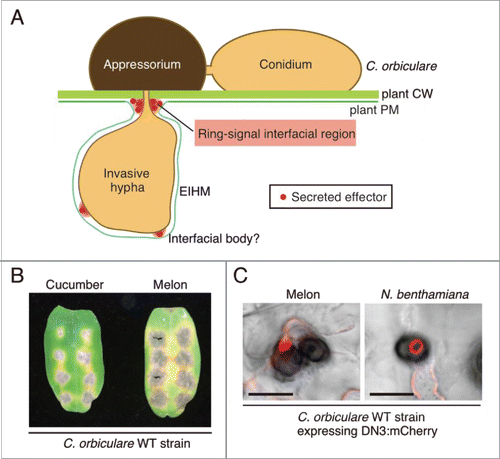Figures & data
Figure 1. C. orbiculare secretes effectors at the interfacial region, as visualized by DN3:mCherry as a ring signal, during the susceptible interaction with multiple plant species. (A) Schematic model of the spatial secretion strategy of the effectors in C. orbiculare for plant infection. Using melanized appressorium, C. orbiculare penetrates the cell wall (CW) of susceptible plants and subsequently develops biotrophic invasive hyphae. The developed biotrophic invasive hyphae are surrounded by the extrainvasive hyphal membrane (EIHM), which is continuous with the plant plasma membrane (PM). C. orbiculare preferentially secretes virulence-related effectors, such as DN3, at the interfacial region located around the neck region of primary biotrophic invasive hyphae, which is called ring-signal interfacial region. C. orbiculare also likely secretes effectors at randomly distributed interfacial bodies. (B) Inoculation of the C. orbiculare wild-type (WT) strain 104-T on cotyledons of both melon and cucumber. A conidial suspension (5 × 105 conidia/mL) of 104-T was drop-inoculated on cotyledons of both melon and cucumber, and the inoculated plants were incubated for 7 d. (C) Focal accumulation of the DN3 effector, which is secreted by C. orbiculare during the susceptible interaction with multiple plant species. A C. orbiculare WT strain expressing the DN3 effector:mCherry fusion protein under the TEF promoter was inoculated on melon cotyledons or N. benthamiana leaves. Images were taken at 3 d postinoculation (dpi) for melon and at 4 dpi for N. benthamiana using confocal laser scanning microscopy. Bars = 10 μm.

